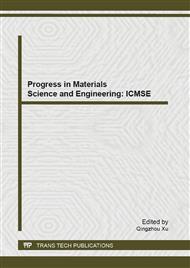[1]
E. J. Jung, B. M. Moon, D. J. Min, Quantitative evaluation of methods for effective removal of impurities to produce solar-grade silicon, J. Current Applied Physics. (2013)1-5.
DOI: 10.1016/j.cap.2013.02.001
Google Scholar
[2]
M. D. Johnston, M. Barati, Effect of slag basicity and oxygen potential on the distribution of boron and phosphorus between slag and silicon,J. Journal of Non-Crystalline Solids. 357(2011)970-975.
DOI: 10.1016/j.jnoncrysol.2010.10.033
Google Scholar
[3]
N. S. F. T. a. A. Tagaya, Thermodynamics of phosphorus in Cao-CaF2-SiO2 and CaO-CaF2-CaCl2 melts saturated with CaO. ISIJ International. 31 (1991)1345-1347.
DOI: 10.2355/isijinternational.31.1345
Google Scholar
[4]
Y. Zhang, R. Zhang, E. Kasai, S. Li, Vaporization behavior of lead from the FeO-CaO-SiO2-Al2O3 slag system,J. Journal of University of Science and Technology Beijing, Mineral, Metallurgy, Material. 15 (2008)671-677.
DOI: 10.1016/s1005-8850(08)60269-8
Google Scholar
[5]
Y. k. Y. Hiroaki Kawamura, T. Yoshikawa, K. Morita, Reductive removal of phosphorus in silicon using CaO-CaF2 slag. EPD Congress 2013 TMS (The Minerals, Metals & Materials Society), (2013) 229-236.
DOI: 10.1002/9781118658468.ch26
Google Scholar
[6]
S. Z. E. Krystad, G . Tranell, The kinetics of boron removal during slag refining in the production of solar-grade silicon. EPD Congress. (2012) 471-480.
DOI: 10.1002/9781118359341.ch56
Google Scholar
[7]
C.H.P. Lupis, Chemical Thermodynamics of Materials, Elsevier Science Press, New York, (1993).
Google Scholar
[8]
I.H. Jung, Y.M. Zhang, Thermodynamic Calculations for the Dephosphorization of Silicon Using Molten Slag ,J. TMS, 26(2012) 973-981.
DOI: 10.1007/s11837-012-0387-0
Google Scholar
[9]
P. Chartrand, S. A. Degterov, G. Eriksson, K. Hack, B.R. Mahfoud, J. Melançon, A.D. Pelton, S. Petersen, FactSage thermochemical software and databases, Calphad, J. 26(2002)189-228.
DOI: 10.1016/s0364-5916(02)00035-4
Google Scholar
[10]
D. Min ,N. Sano, Determination of standard free energies of formation of Ca3P2 and Ca2Sn at high temperatures,J. Metallurgical and Materials Transactions B. 19(1988)433-439.
DOI: 10.1007/bf02657741
Google Scholar
[11]
A. R. M. Yindong Yan, I. D. Sommerville, Phosphate and sulphide capacities of CaO-CaCl2-CaF2 slags,J. Canadian Metallurgical Quarterly. 8(1997)347-354.
DOI: 10.1016/s0008-4433(97)00027-x
Google Scholar


